A preserved steam railway.
The line runs 18 miles from Pickering to Grosmont, with a total of five stations. There is a connecting service onwards to Whitby on the coast, also apparently steam hauled. Network Rail trains serve Whitby and Grosmont too, but the tickets may not be valid on both services. For the enthusiast, the stock book lists about a dozen each of steam and diesel locos, and several dozen coaches and wagons.
The website says that on some dates services are available along the Esk Valley line, which runs from Whitby via Grosmont to Battersby – a 24 mile run, but I couldn’t find any timetable, so if you are interested you should telephone them.
FYI, the Esk Valley line is normally used for the Network Rail Whitby-Middleborough service.
Of the stations, Pickering is a tourist destination, with a castle, Goathland is the film set for “Aidensfield” in a well-known TV series, and Whitby is a port and seaside resort, and folk festival venue. The NYMR base is at Grosmont.
I remember breaking my journey at Goathland for a lengthy walk which stretched my enthusiasm for walking far beyond its limits as I tried to reach some now-forgotten goal. There is a pretty gorge with waterfall near Goathland which is a popular destination for walkers if I remember correctly.
As for the train trip, I was somewhat disappointed to discover that the line lies mostly in wooded valleys with no view of the moors. You can see more of the scenery by driving the A169 from Pickering to Whitby (or at least your passengers will :-).)
This railway is worth a visit whether your interest is fired by tourism or a passion for steam trains.
Mount Grace Priory, Yorks.
English Heritage
In a grassy space are substantial ruins of the small priory church, and of the four-room cells inhabited by the monks. One of the cells has been restored and furnished to show how the monks lived. Each Carthusian monk mostly lived alone in his cell, to which meals were brought. Each cell had its own garden, and its own running water and primitive toilet.
An interesting site, worth a visit if you are in the area.
Knebworth House, Herts.
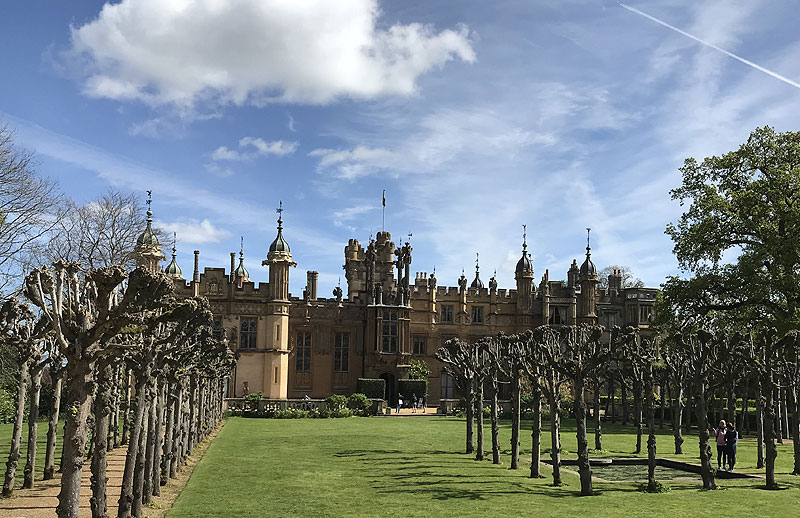 Private
Private
Knebworth House is famous for the rock concerts held in its park, and, by the more discerning, as the home of Victorian novelist Edward Bulwer Lytton – author of the words “The pen is mightier than the sword”. The house is mainly a Victorian Gothic creation, but a Tudor house was on the site before drastic remodelling in the 19th century. A liberal array of fancy domes and turrets are vividly contrasted with carved bats, griffins and grotesque gargoyles. Charles Dickens and Winston Churchill often visited the house.
Today’s visitor can see the Banqueting Hall, with its varied 17th century influences and craftsmanship, and other rooms of interest. There are two rooms entirely dedicated to the life and works of Sir Edward Bulwer-Lytton, with several personal knick knacks and mementoes highlighting his colourful character. The state drawing room is distinctly Victorian-Gothic, but other areas, including the dining parlour, are typical of the Edwardian re-styling adopted by Lutyens.
Outside there are 25 acres of gardens, including a walled kitchen garden and a dinosaur trail, and the church, as well as the park famed for its rock concerts. Scattered around the gardens are various large and small sculptures, mainly in wood.
Worth a visit, and you can divert yourself for at least half a day as there is plenty to look at. In my ill-spent youth I lived nearby and attended several rock concerts in the park.
It is worth visiting the exhibition in the couryard, which has memorabilia of the numerous movies filmed in the house and grounds, the rock concerts held in the park, and the family connections with Imperial India.
First visit 2005. All photos 2024.
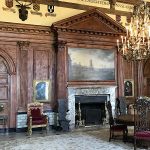
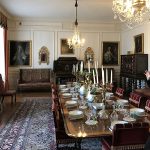
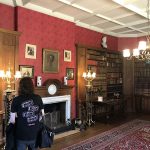
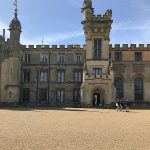
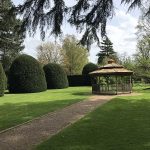



Helmsley Castle, Yorks.
English Heritage.
The castle, originally a medaeval fortress, later acquired a luxurious Tudor house within its walls. The castle was rendered unusable at the end of the Civil War. Later still, it was regarded as a Victorian romantic ruin.
Today, the circuit of walls is largely intact. Inside is a wide area of grassy lawn. The visitor enters via a gatehouse and can look at the half of the keep still standing, the other half having been blown up and allowed to fall into the moat. The Tudor residence is now used as an exhibition space. An audio guide is available.
The castle is definitely worth a visit if you are in the area. Other EH properties are nearby.
Hardwick Old Hall, Derbyshire
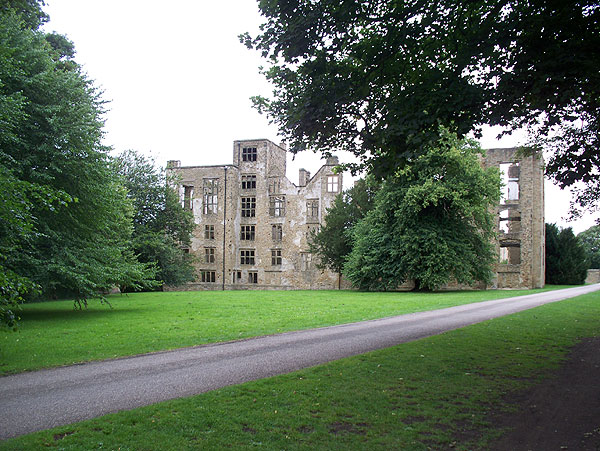 English Heritage
English Heritage
The old hall was remodelled by Elisabeth Shrewsbury before she had the new hall built. The roofless ruins still stand to almost their original height, and visitors can ascend four floors to view surviving decorative plasterwork. Kitchens and service rooms are also visible. The house was partly dismantled in the 1750’s. An audio tour is available, and there is an exhibition in the West Lodge describing Bess’s adventures in architecture.
Hardwick Hall, Derbyshire
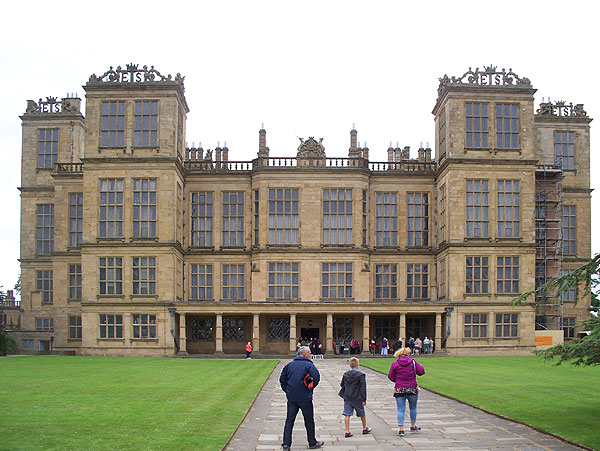 National Trust.
National Trust.
Hardwick Hall is one of the best-known of the NT houses. This Elizabethan house stands on a hilltop, looking big, smart, symmetrical and impressive. The tag “Hardwick Hall, more window than wall” was coined to describe it, and indeed it seems to have a window/wall ratio rather greater than that of my Victorian house and more typical of a public building. The design looks timeless owing to this particular look being copied in later centuries. Everything about the place seems calculated to impress by its size and grandeur. There are at least two big stone staircases, and on ascending one of them, one enters the High Great Chamber on the second floor. This is a very big and very high room and lavishly decorated, the Elizabethan decorations being largely unchanged. There is also a long gallery which is quite high and very long, and crammed with 80 portraits.
In the Dining Room the Sea-dog table is supported by four superbly carved chimeras and four tortoises.
The first floor rooms are now all open to visitors. The house has six towers incorporated in the structure, and atop the towers are the initials of the house’s first owner, Elizabeth Shrewsbury, in letters at least six feet high.
Close by are the ruins of Harwick Old Hall (English Heritage), which is in fact little older than the new Hall, but was allowed to fall into disrepair in more recent years.
Don’t miss a chance to visit. A visit to both Halls and their grounds will occupy several hours. Nearby on the Hardwick estate is Stainsby Mill (NT), a water-mill in working order. (revisited July 2017)
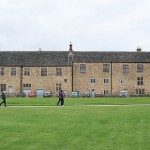
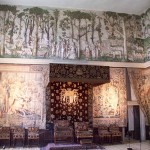
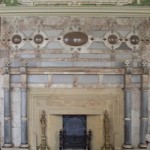
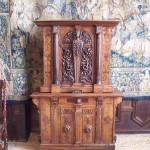
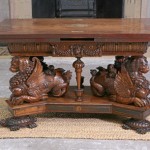
Fountains Abbey, Yorks.
National Trust & English Heritage
Fountains Abbey is now rated as a World Heritage Site. The abbey ruins are unusually complete, with many parts standing at near their original height. Perhaps the site was too remote to be extensively pillaged for building stone. There is much to see and do on site. Besides exploring the extensive abbey ruins, you can explore the beautifully landscaped Georgian water garden of Studley Royal, and visit Elizabethan Fountains Hall, the Cistercian monastery corn mill, and St Mary’s Church.
The gardens have a lake and many temples and follies, and even a twisting tunnel designed to give visitors a mild scare. If you are a fan of William Burges, do not miss the Victorian church, which looks plain on the outside, but inside is a riot of Victorian Gothic colour and carved ornamentation in wood and stone.
You should plan for an all-day visit.
Duncombe Park, Yorks.
The house, flanked by two large square service wings, is set in extensive parkland. The house was completed in 1713 and remodelled in 1843. The central block was gutted by fire in 1879 and not rebuilt till 1895, with a slightly revised layout.
I visited Duncombe Park in 2005. Inside, there is the Stone Hall, a lavishly decorated forty-foot cube, and other fine rooms with period furnishings. The house is no longer open to the public, but you can still visit the park and gardens, which are open several days a week during the warmer months.
(If you are curious to see what the house is like inside, check Weddings/Ceremony Locations on the Park website, or enquire about the Special Events.)
The gardens are quite extensive and include two temples, a large formal terrace, and a ruined conservatory.
Cliffords Tower, York
The tower comprises an unusual quatrefoil shell wall, built on top of a high mound. It’s almost all that remains of York Castle. Visitors can climb to the top of the wall, which affords great views over the central parts of York. The middle of the tower, which may once have been roofed, is now an open courtyard. If I remember correctly, there are a few relics and exhibits to look at inside the tower.
If you’re disabled, check photos of the mound and tower before planning your visit 🙁
There is a pay car park nearby, but you probably don’t want to be driving around the centre of York during the day, and you may find access on foot or by bus less troublesome.
Charlecote Park, Warwickshire
The long red-brick house, spiky with gables and chimneys, sits close to a ponded stream. Parts of the house date from the sixteenth century. The house is built on an irregular E-plan, and has Queen Elizabeth I’s coat of arms displayed over the porch. Though Charlecote looks like an Elizabethan mansion, most of it dates from the early nineteenth century. The nineteenth-century interiors are also finished in Elizabethan style. There is a fine collection of books, and some fine furniture.
Outside are outbuildings, some of them older than the house, including a brew-house, a wash-house, and a coach-house displaying a collection of vehicles used at Charlecote in the nineteenth century.
